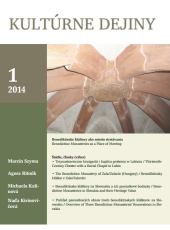Trzynastowieczne krużganki i kaplica grobowa w Lubiniu
Thirteenth-Century Cloister with a Burial Chapel in Lubin
Author(s): György SzabadosSubject(s): History
Published by: VERBUM - vydavateľstvo Katolíckej univerzity v Ružomberku
Keywords: history; Middle Ages; benedictine abbeys; Poland; Lubin
Summary/Abstract: Archeological research in Benedictine monastery in Lubin (in Greater Poland) revealed, among others, the remains of the thirteenth-century cloister. It had four galleries and various chambers, including a chapter house and a burial chapel next to it. The positioning and way of use of the chapel allow to include it to a group of Benedictine Marian chapels associated with chapter houses and occurring in the monasteries of the congregation of Cluny and that of Hirsau. Customs of Hirsau may have been known and partially adopted in the Lubin abbey, impacting on the sacred topography of its cloister. Benedictine monastery in Lubin (in Greater Poland) was founded at the end of the reign of King Bolesław II the Generous (1054 – 1079) . After the rapid fall, the abbey was re-established at ca. 1138-39. Shortly thereafter, the stone church was built, the main altar of which was consecrated in the year 1145. Even in the twelfth century, the church and the oldest monastery buildings (probably wooden) were surrounded by a wall. Before the end of the century the first stone monastery buildings were erected, which began to form the two oldest wings of the future cloister. The chapter house was, as usual, in the eastern wing. In the first half of the thirteenth century four galleries of unequal width were constructed in order to complete the cloister. At the same time, a chapel was built next to the chapter house. As shown by archeological research, chapel had its own altar and a place for fixing the processional cross. Among many tombs in the chamber, the oldest was the burial of an unidentified prelate, equipped with a crosier. Location and way of use of the chapel allow to include it to a group of Benedictine Marian chapels associated with chapter houses and occurring in the monasteries of the congregation of Cluny and that of Hirsau. The Lubin abbey did never belong to any of them. However, customs of Hirsau may have been known and partially adopted in the Lubin abbey, impacting on the sacred topography of its cloister. The reform of Hirsau were well known in Greater Poland, especially in Mogilno abbey, where they have been introduced probably between the year 1112 and 1124.
Journal: Kultúrne dejiny
- Issue Year: 2014
- Issue No: 1
- Page Range: 6-18
- Page Count: 13
- Language: Polish

